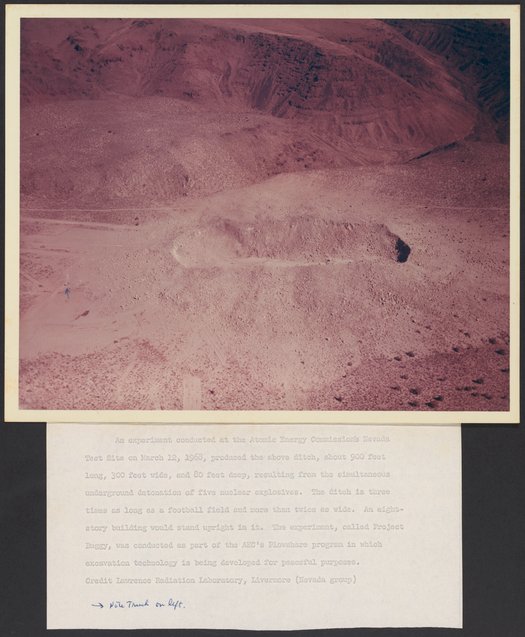Ditch created by Project Gasbuggy
- 1968-Mar-12

Rights
Download all 2 images
PDFZIPof full-sized JPGsDownload selected image
Small JPG1200 x 1457px — 295 KBLarge JPG2880 x 3496px — 1.5 MBFull-sized JPG6203 x 7529px — 5.8 MBOriginal fileTIFF — 6203 x 7529px — 134 MBPhotograph of a ditch created by a test explosion at the Atomic Energy Commission's Nevada Test Site on March 12, 1968. The test was conducted as part of the Gasbuggy (erroneously identified as "Project Buggy" in the caption accompanying the photograph.)
Project Gasbuggy was a joint experiment by the United States Atomic Energy Commission (AEC), the Department of the Interior, and the El Paso Natural Gas Company, to determine if nuclear explosives could be used to extract natural gas. Project Gasbuggy was part of Project Plowshare, the AEC's effort to develop peacetime uses for nuclear explosives.
| Property | Value |
|---|---|
| Place of creation | |
| Format | |
| Genre | |
| Extent |
|
| Language | |
| Subject | |
| Rights | Public Domain Mark 1.0 |
| Credit line |
|
Institutional location
| Department | |
|---|---|
| Collection | |
| Physical container |
|
View collection guide View in library catalog
Related Items
Cite as
“Ditch Created by Project Gasbuggy,” March 12, 1968. Photographs from the Papers of Spofford Grady English, Box 1, Folder 17. Science History Institute. Philadelphia. https://digital.sciencehistory.org/works/p8ahpuy.
This citation is automatically generated and may contain errors.
Rights
Download all 2 images
Searchable PDFmay contain errorsZIPof full-sized JPGsDownload selected image
-
Keyboard Shortcuts
Previous image shift + or , Next image shift + or . Pan image Zoom in + or shift + Zoom out - or shift + Zoom to fit 0 Close viewer esc Also
Mouse click to zoom in; shift-click to zoom out. Drag to pan. Pinch to zoom on touch.






